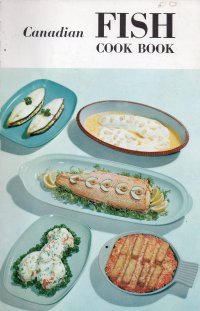Notes from Canada on How to Cook Fish: Canadian Fish Cook Book
or several ways to cook the various fishes, all of which (almost) amount to the same thing
Beginning in 1959, the Canadian Department of fisheries in Ottawa published its Canadian Fish Cook Book. The spiral bound guide is one of the ugliest publications ever printed outside of the Soviet Bloc an its cover betrays an unfortunate an predilection for fancifully shaped and beige food. The booklet went through many editions and remained in print at least through 1974. It cost only a loonie and its transparent purpose was to prop up the Canadian fishing industry: The Cook Book would make fish more accessible to the carnivorous if otherwise upright, not to say Doright, citizens of the ordered and great white north.
 The legendary James Beard loved this little booklet and not only followed its strictures on cooking fish, but also lauded it in print and quoted it at length. Beard had a point, for if the Canadian guidelines lack a certain subtlety, they also provide the pescatory novitiate with the assurance that his fish dish will not founder. Confidence is all: Once someone has prepared a number of dishes using different fishes, he can calibrate his cooking times from the Canadian model to accommodate the texture and densities of the various species.
The legendary James Beard loved this little booklet and not only followed its strictures on cooking fish, but also lauded it in print and quoted it at length. Beard had a point, for if the Canadian guidelines lack a certain subtlety, they also provide the pescatory novitiate with the assurance that his fish dish will not founder. Confidence is all: Once someone has prepared a number of dishes using different fishes, he can calibrate his cooking times from the Canadian model to accommodate the texture and densities of the various species.
The Cook Book begins at the beginning, with concise instructions for scaling, gutting, skinning, boning and steaking. When it comes time to cook the catch, the introductory guidance is both commonsense and exemplary:
“You will know your fish is cooked when:
1. The flesh loses its translucent appearance and becomes opaque
2. The flesh flakes readily
3. The flesh is easily pierced with a fork.
Serve fish immediately, while it is still piping hot, tender and juicy.
Do not overcook. Overcooking dries and toughens fish….
Remember any fish can be cooked by any method…. [Y]ou will note that some recipes call for a certain variety of fish. You may substitute other varieties of fish and still obtain good results.” (Cook Book 8)
Veterans of the fish station will note some unstated exceptions, for example that swordfish ought never flake, or that cod dislikes grilling over open charcoal, but these are quibbles. In the main the Ministry has advanced its goal of removing the mystery for those consumers unfamiliar with fish or some of its forms.
The lesson continues with instructions for baking whole fish, stuffed and unstuffed, filleted and steaked; for oven steaming and broiling; for panfrying and deep frying; for cooking ‘in water’ and in milk.
What these disparate methods share in the context of cooking time, according to the Ministry of Fisheries, is everything. When baking stuffed fish of any kind, bake it for 10 minutes per inch of stuffed fish. If, however, you do not stuff your fish, then bake it for 10 minutes per inch of fish. Fish should be steamed, broiled, panfried or deep fried for 10 minutes per inch of thickness, and cooking fish in liquids requires... 10 minutes per inch....
All this uniformity is rescued from calamity by the Ministry’s willingness to vary cooking temperatures. The discerning reader must note that this approach is a brilliant means of reducing those variables that can make an enterprising but unsure newcomer confused and distracted. Temperatures are preset and food is preseasoned; once the fish is on the fire, all our aspirant need remember is the 10 minute mantra. It has not in the main failed the Editor, although it would be well to purchase insurance in the form of the visual inspection outlined in the numbered notations previously quoted.
Some of the sauces and combinations suggested by the Ministry are another thing; after all, the civil servants compiled their Cook Book in 1959, during an era of experimentation with ghastlies like ground beef casserole bound with grape jelly, but so what? Once again resort to common sense, eschew the ‘Halibut Oriental’ featuring dill pickles and pineapple, the minted pickerel and the banana topping for sole. Choose instead the apple bread or seafood stuffing, the orange butter or Marguery sauce (weirdly featuring ‘hot wine liquid;’ use common sense and white wine unless you serve salmon, when you might like a red) or something from another source. In any event, however, obey the 10 minute rule with its visual corollary and you cannot go far wrong.
It would be tedious to reproduce recipes from the Canadian Fish Cook Book when copies are expansively available from the Advanced Book Exchange and other online sources for the merest snippet of a verse from a song.

